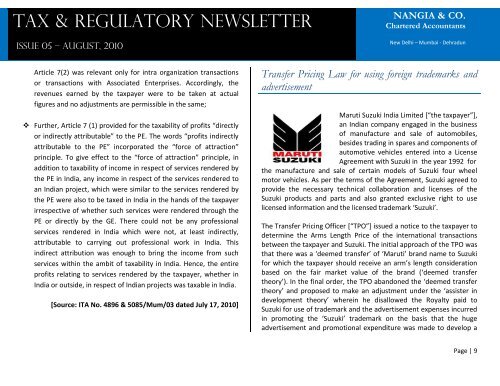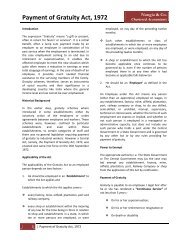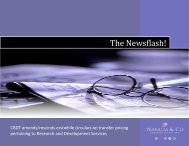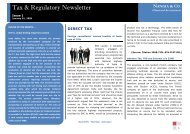DIRECT TAX - Nangia & Co
DIRECT TAX - Nangia & Co
DIRECT TAX - Nangia & Co
Create successful ePaper yourself
Turn your PDF publications into a flip-book with our unique Google optimized e-Paper software.
Tax & Regulatory Newsletter<br />
Issue 05 – AUGUST, 2010<br />
NANGIA & CO.<br />
Chartered Accountants<br />
New Delhi – Mumbai - Dehradun<br />
Article 7(2) was relevant only for intra organization transactions<br />
or transactions with Associated Enterprises. Accordingly, the<br />
revenues earned by the taxpayer were to be taken at actual<br />
figures and no adjustments are permissible in the same;<br />
Further, Article 7 (1) provided for the taxability of profits “directly<br />
or indirectly attributable” to the PE. The words “profits indirectly<br />
attributable to the PE” incorporated the “force of attraction”<br />
principle. To give effect to the “force of attraction” principle, in<br />
addition to taxability of income in respect of services rendered by<br />
the PE in India, any income in respect of the services rendered to<br />
an Indian project, which were similar to the services rendered by<br />
the PE were also to be taxed in India in the hands of the taxpayer<br />
irrespective of whether such services were rendered through the<br />
PE or directly by the GE. There could not be any professional<br />
services rendered in India which were not, at least indirectly,<br />
attributable to carrying out professional work in India. This<br />
indirect attribution was enough to bring the income from such<br />
services within the ambit of taxability in India. Hence, the entire<br />
profits relating to services rendered by the taxpayer, whether in<br />
India or outside, in respect of Indian projects was taxable in India.<br />
[Source: ITA No. 4896 & 5085/Mum/03 dated July 17, 2010]<br />
Transfer Pricing Law for using foreign trademarks and<br />
advertisement<br />
Maruti Suzuki India Limited *“the taxpayer”+,<br />
an Indian company engaged in the business<br />
of manufacture and sale of automobiles,<br />
besides trading in spares and components of<br />
automotive vehicles entered into a License<br />
Agreement with Suzuki in the year 1992 for<br />
the manufacture and sale of certain models of Suzuki four wheel<br />
motor vehicles. As per the terms of the Agreement, Suzuki agreed to<br />
provide the necessary technical collaboration and licenses of the<br />
Suzuki products and parts and also granted exclusive right to use<br />
licensed information and the licensed trademark ‘Suzuki’.<br />
The Transfer Pricing Officer *“TPO”+ issued a notice to the taxpayer to<br />
determine the Arms Length Price of the international transactions<br />
between the taxpayer and Suzuki. The initial approach of the TPO was<br />
that there was a ‘deemed transfer’ of ‘Maruti’ brand name to Suzuki<br />
for which the taxpayer should receive an arm’s length consideration<br />
based on the fair market value of the brand (‘deemed transfer<br />
theory’). In the final order, the TPO abandoned the ‘deemed transfer<br />
theory’ and proposed to make an adjustment under the ‘assister in<br />
development theory’ wherein he disallowed the Royalty paid to<br />
Suzuki for use of trademark and the advertisement expenses incurred<br />
in promoting the ‘Suzuki’ trademark on the basis that the huge<br />
advertisement and promotional expenditure was made to develop a<br />
Page | 9









